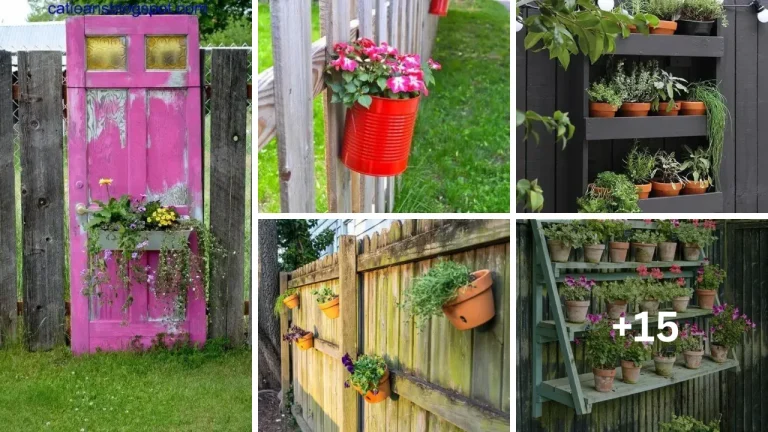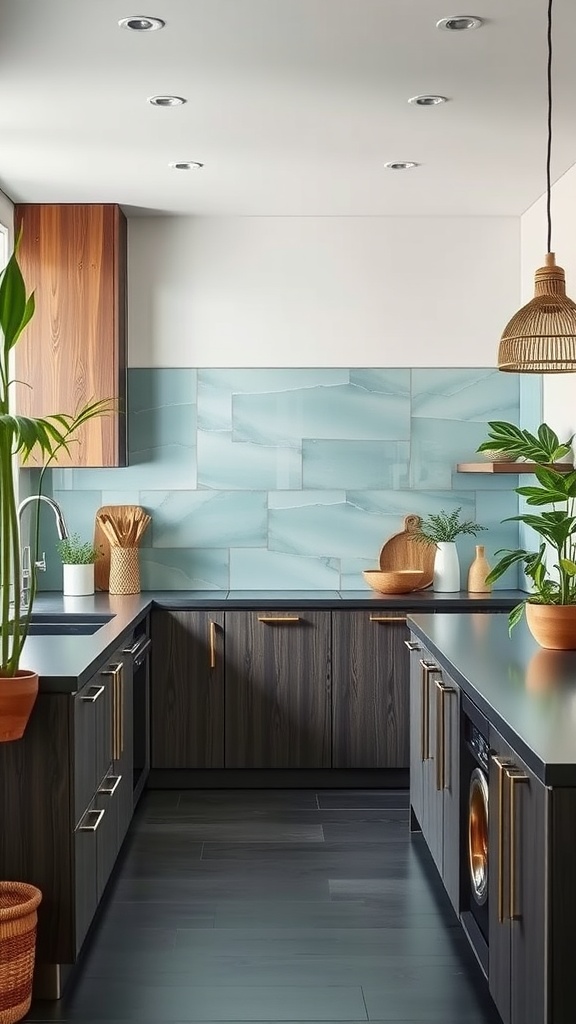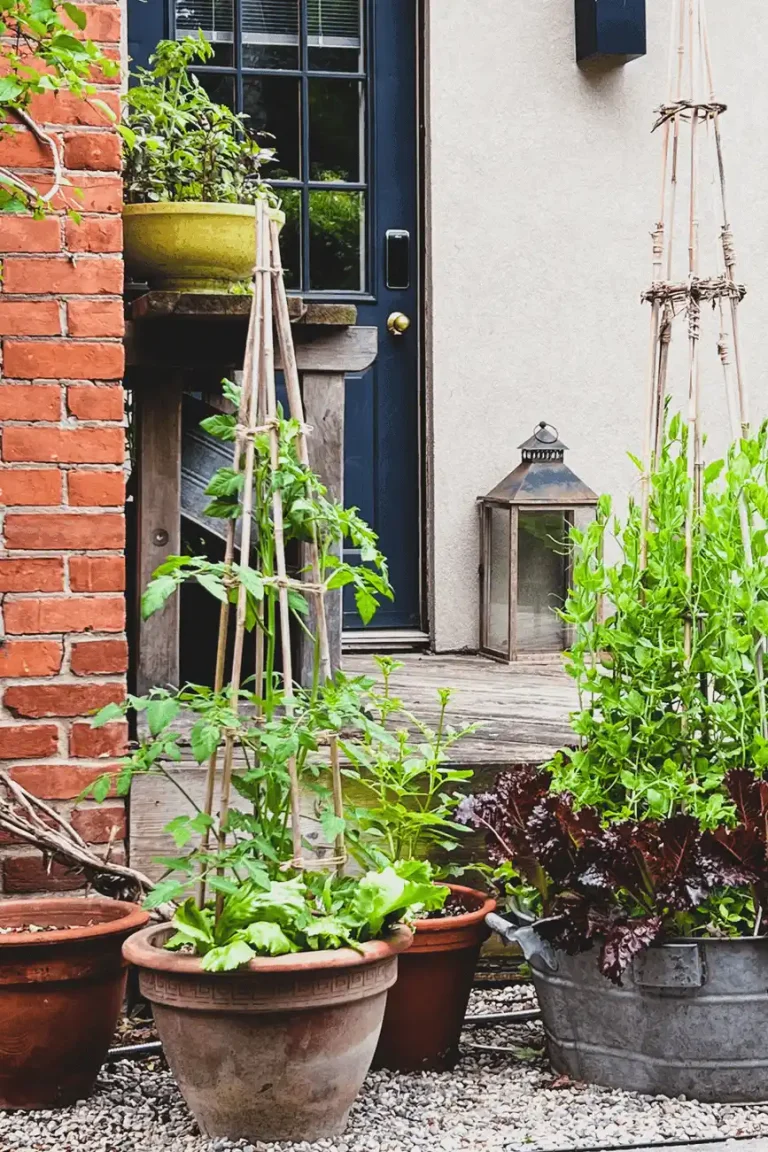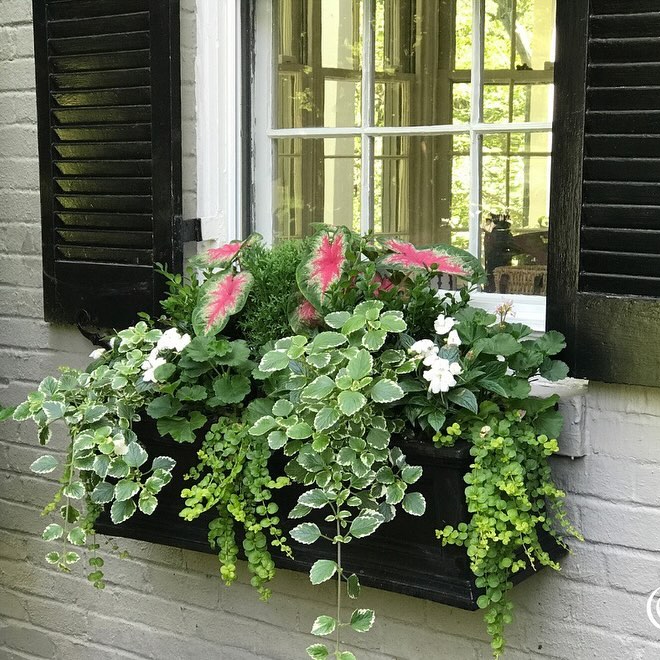17 Inspiring Tomato Trellis Ideas for Your Garden
Growing tomatoes at home can be incredibly rewarding, but finding the right support for your plants can make all the difference. A tomato trellis is more than just a functional tool; it’s an essential part of creating a thriving garden. Whether you’re a beginner gardener or an experienced green thumb, choosing the right tomato trellis for your space can maximize your harvest, reduce disease risk, and help your plants grow strong and healthy. In this listicle, we’ll cover 17 tomato trellis ideas that cater to different needs, spaces, and aesthetics. Let’s dive in with the first 11 ideas!
1. Classic Wooden A-Frame Trellis
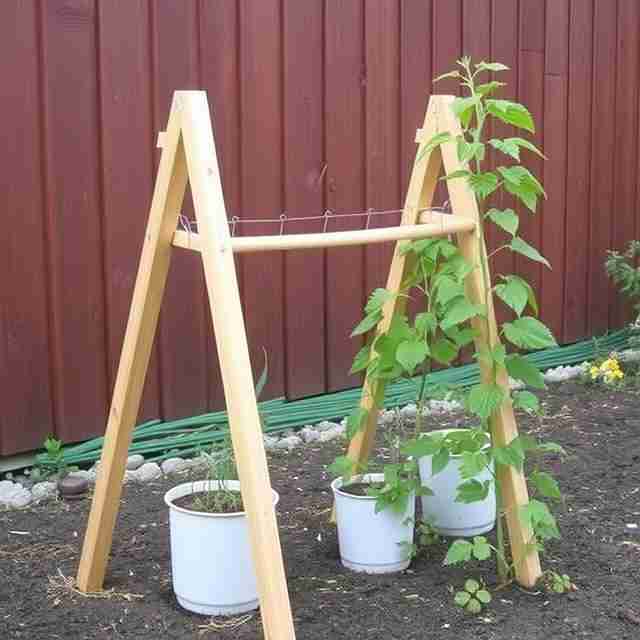
The classic wooden A-frame trellis is a timeless solution that combines functionality with rustic charm. This design uses two vertical wooden poles connected by horizontal beams, forming a simple A-shaped frame. It’s perfect for gardeners who want a solid and easy-to-build structure to support their tomato plants.
Why it Works:
- Sturdy Support: The A-frame structure provides strong vertical support for tomato vines, preventing them from sprawling on the ground, which can lead to diseases.
- Space-Saving: The design allows you to grow tomatoes vertically, saving space in smaller gardens or even container setups.
- Aesthetic Appeal: The wooden frame offers a natural, rustic look that blends seamlessly with most garden styles, whether it’s a modern backyard or a cottage garden.
How to Build It:
- Start with two sturdy wooden poles or beams, each about 6 feet tall.
- Connect them at the top with a horizontal beam to form the “A” shape.
- Add several horizontal crossbars for the tomatoes to cling to as they grow.
- Use string or twine to tie the vines to the crossbars for added support.
This simple yet effective design is easy to build and maintain, making it a popular choice among gardeners.
2. Vertical PVC Pipe Trellis
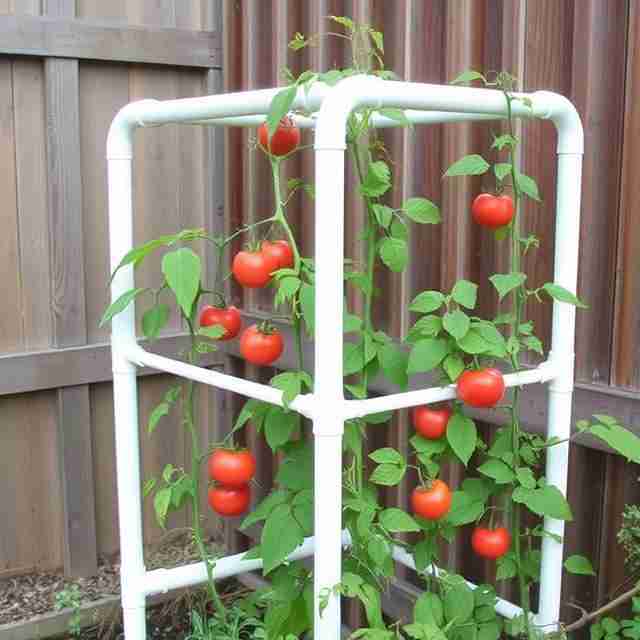
PVC pipes are a budget-friendly and lightweight material that can be transformed into a highly functional trellis for tomato plants. The vertical PVC pipe trellis design uses vertical pipes connected with horizontal pipes to create a sturdy structure for growing tomatoes upward.
Why it Works:
- Lightweight and Affordable: PVC is easy to work with, relatively inexpensive, and widely available.
- Durable: PVC pipes are resistant to weather elements, meaning this trellis will last for several growing seasons.
- Easy to Maintain: The smooth surface of PVC makes it easy to clean and doesn’t absorb moisture, which can reduce the risk of diseases that typically affect wooden trellises.
How to Build It:
- Cut several lengths of PVC pipe (6 feet or taller, depending on the height of your tomato plants).
- Secure the pipes to the ground using stakes or anchors.
- Connect the vertical pipes with horizontal pieces to create a frame.
- Use twine or tomato clips to train the plants upwards as they grow.
The PVC pipe trellis is a modern, clean-looking option that provides reliable support for your tomatoes.
3. Trellis Wall System

A trellis wall system is a perfect solution for gardeners who want to maximize their space, especially in urban areas or small gardens. This system uses the wall of a building or fence to support tomato vines, saving valuable ground space.
Why it Works:
- Space Efficiency: By growing tomatoes vertically against a wall, you free up precious garden space for other plants or outdoor activities.
- Maximizes Sunlight Exposure: Tomatoes need plenty of sun to thrive, and a trellis wall system ensures that the plants receive maximum sunlight exposure throughout the day.
- Easy to Maintain: With the plants growing upwards, they are easier to tend to, and you can easily harvest tomatoes without bending down.
How to Build It:
- Install hooks or eye screws into the wall at regular intervals.
- Stretch sturdy wire or twine between the hooks to create horizontal lines for the tomatoes to climb.
- As the tomatoes grow, tie the vines to the wires to keep them upright and off the ground.
This option is ideal for gardens with limited space or for those who want to add a vertical garden feature to their backyard.
4. Cattle Panel Trellis

Cattle panels are large, rectangular wire panels typically used for fencing, but they make an excellent tomato trellis. This trellis is known for its durability and ease of setup. A cattle panel trellis can be used as a stand-alone structure or attached to an existing fence.
Why it Works:
- Sturdy and Durable: Cattle panels are made from thick galvanized wire, so they can handle the weight of mature tomato plants without bending or breaking.
- Large Surface Area: The grid design offers plenty of space for tomato vines to spread out, encouraging more fruit production.
- Versatile Design: It can be bent into an archway or left standing vertically, depending on your garden’s layout.
How to Build It:
- Purchase a cattle panel from your local farm supply store.
- Secure the panel vertically between two posts, or bend it into an arch shape for a decorative look.
- Tie the tomato plants to the wires as they grow, ensuring they have enough space to stretch out.
A cattle panel trellis is perfect for larger gardens and offers both functionality and style.
5. Arched Wooden Trellis
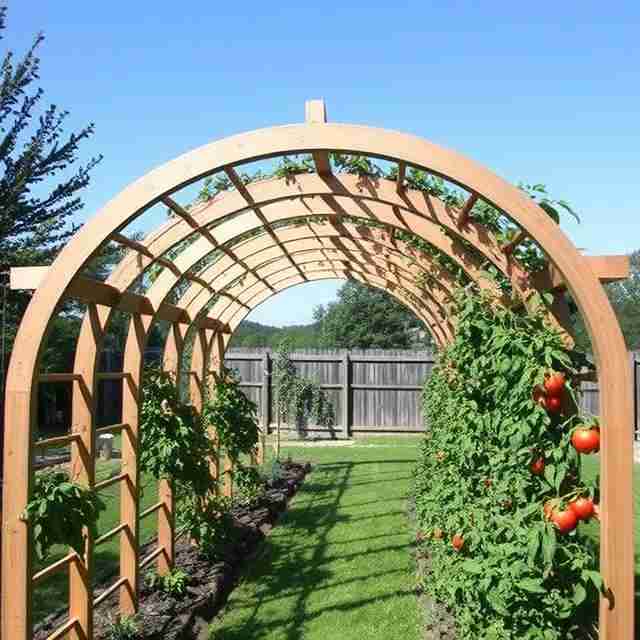
An arched wooden trellis brings both beauty and practicality to your garden. This design uses arch-shaped beams to form a tunnel or archway, creating a visually appealing focal point in your garden while providing ample support for growing tomatoes.
Why it Works:
- Aesthetic Appeal: The arched shape adds a charming, whimsical element to your garden, making it an attractive feature in addition to a practical trellis.
- Ample Growing Space: Tomatoes can grow upwards and outwards along the arch, offering plenty of space for vines to spread.
- Easy Access for Harvesting: The height and shape of the arch make it easy to harvest tomatoes without bending over or getting tangled in vines.
How to Build It:
- Construct two tall wooden posts and secure them in the ground.
- Connect the posts with an arch-shaped beam, using additional horizontal beams to create a sturdy frame.
- Install wire or twine along the arch to provide support for the tomato vines.
This elegant design is ideal for larger gardens and provides both functional and decorative benefits.
6. String and Stake Trellis System
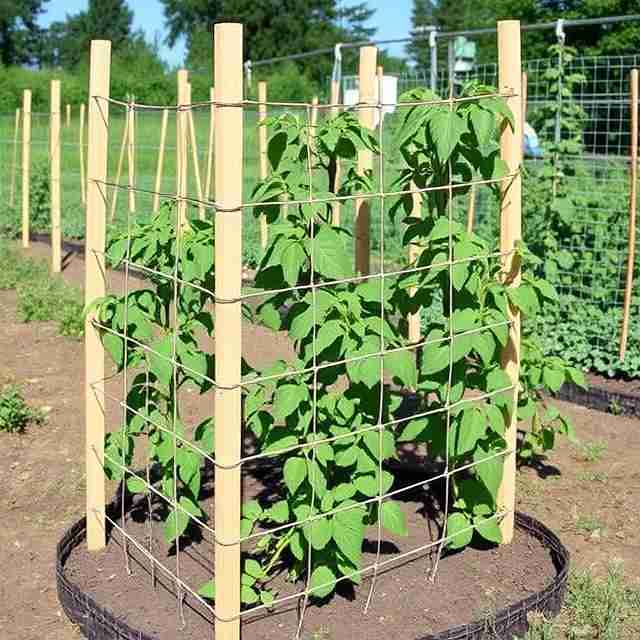
A string and stake trellis system is one of the simplest and most affordable ways to support tomato plants. This design involves using vertical stakes in the ground and stringing twine between them to guide the plants upwards.
Why it Works:
- Low-Cost Option: All you need are stakes and twine, making this an ideal solution for those on a budget.
- Minimal Space Required: The string and stake system allows tomatoes to grow vertically, saving space in smaller gardens or containers.
- Easy to Adjust: You can adjust the height of the string as the tomato plants grow, giving them plenty of room to spread out.
How to Build It:
- Place a row of sturdy stakes about 2 feet apart along the perimeter of your garden.
- Use twine to connect the stakes, creating a grid-like structure for your tomatoes to climb.
- As the tomatoes grow, tie the vines to the twine to keep them upright.
This system is a great DIY option that works well in any garden, large or small.
7. Upcycled Ladder Trellis

For gardeners who love to recycle and repurpose materials, using an old wooden ladder as a tomato trellis is an excellent choice. The ladder provides both horizontal and vertical support, creating a unique and eco-friendly garden feature.
Why it Works:
- Sustainable Option: Using an old ladder means you’re giving new life to a piece of furniture that would otherwise be discarded.
- Rustic Charm: The ladder adds a rustic, farmhouse-style look to your garden, making it both functional and aesthetically pleasing.
- Sturdy Support: The ladder rungs serve as a perfect place for tomato vines to climb.
How to Build It:
- Find an old wooden ladder that’s sturdy enough to support the weight of your tomato plants.
- Place the ladder vertically in your garden, either leaning against a structure or set upright with supports.
- Allow the tomato vines to climb the rungs, and use twine or clips to secure them in place.
This is a great choice for gardeners who want to add personality to their garden while staying eco-conscious.
8. Wire Cage Trellis
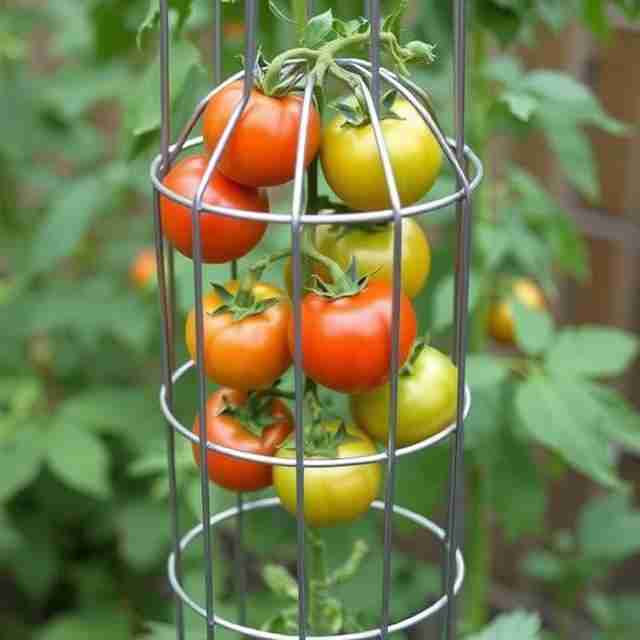
The wire cage trellis is a classic and simple way to support tomato plants. These metal cages come in various sizes and shapes, but they are typically cylindrical, providing ample space for the tomato plants to grow while keeping them upright.
Why it Works:
- Ready-Made Solution: Wire cages are pre-constructed and easy to use, making them perfect for beginner gardeners.
- Space Efficiency: The circular design allows tomatoes to grow inside the cage, which minimizes the footprint of your garden.
- Durable and Low-Maintenance: Made from galvanized steel, wire cages are resistant to rust and weather damage.
How to Use It:
- Place a wire cage around each tomato plant when it’s young, allowing it to grow inside the cage.
- As the plant grows, the cage will provide support, keeping the vines contained and off the ground.
This option is perfect for gardeners looking for an easy, no-fuss solution for tomato support.
Welcome back to Part 2 of our 17 Tomato Trellis Ideas! In the first part, we covered some fantastic trellis ideas ranging from classic wooden designs to creative upcycled options. Now, we’ll dive into the remaining 6 trellis ideas and provide you with the final pieces to complete your garden support system. Let’s get started!
9. DIY Tomato Cage Trellis
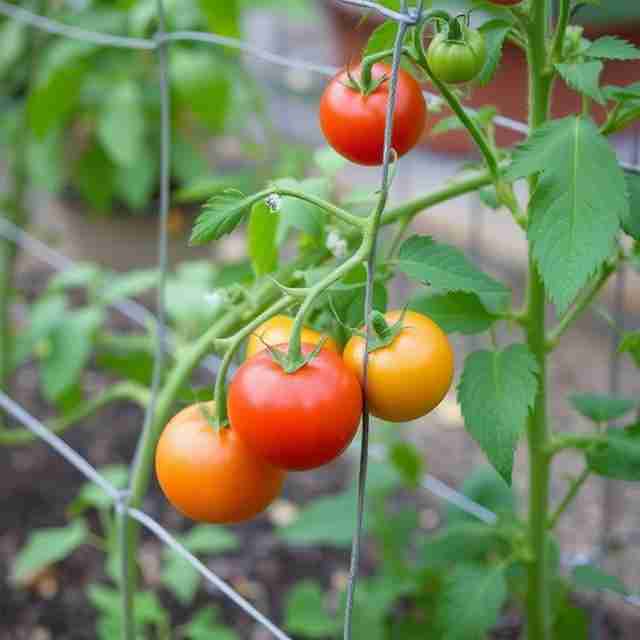
For gardeners who love hands-on projects, creating your own DIY tomato cages can be a fun and rewarding experience. Using simple materials like wire mesh, you can design tomato cages that are tailored to the size and shape of your garden.
Why it Works:
- Customizable: You can adjust the height and width of the cage to suit the variety of tomatoes you’re growing.
- Affordable: Wire mesh is an inexpensive material that can be found at most hardware stores, making this an affordable DIY option.
- Sturdy Support: Once assembled, DIY cages offer excellent support for your tomato plants as they grow taller and heavier.
How to Build It:
- Cut a piece of wire mesh to the desired height of your cage, usually about 4 to 5 feet tall.
- Form the mesh into a cylinder and secure the ends with wire or zip ties.
- Place the cage around your tomato plant early in the season to guide growth.
- Use additional support wires or stakes if needed to secure the cage further.
DIY tomato cages allow for maximum flexibility, and they’re a great way to add a personal touch to your garden.
10. Trellis Arch for Patio Gardens

If you’re gardening in a small space or on a patio, a trellis arch is a fantastic way to maximize vertical space while adding a beautiful structure to your garden. This type of trellis forms an archway for your tomatoes to climb and spread, creating a charming entryway or a focal point.
Why it Works:
- Space-Saving: By growing tomatoes vertically, you free up space on the ground for other plants or outdoor activities.
- Stylish and Functional: The trellis arch is as much about aesthetics as it is about support. It creates a stunning garden feature that will catch the eye.
- Perfect for Small Gardens: Ideal for patio gardens, balcony setups, or narrow garden beds where you need to make the most of limited space.
How to Build It:
- Start by installing two tall posts into the ground at a distance that suits the width of your arch.
- Connect the top of the posts with an arched beam to form the arch shape.
- Add wire or twine along the arch to provide support for the tomato vines.
- Tie your tomato plants to the wire as they grow.
A trellis arch is a wonderful solution for small urban gardens, offering both beauty and functionality.
11. Freestanding Metal Trellis
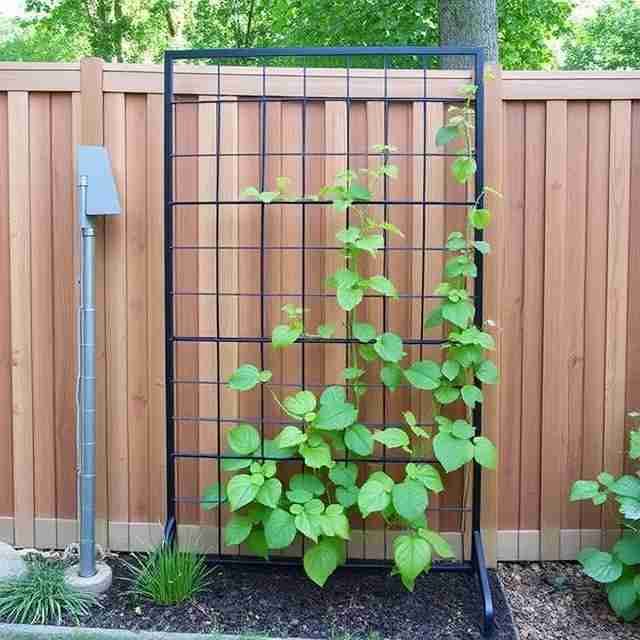
A freestanding metal trellis provides a contemporary, minimalist design that can fit well in almost any garden. These trellises are often made from powder-coated steel, which gives them a sleek and durable finish.
Why it Works:
- Modern Aesthetic: The clean lines and minimalist design of a metal trellis add a modern touch to your garden.
- Long-Lasting: Metal trellises are extremely durable, resistant to weathering, and can last for many seasons.
- Easy to Move: Since they are freestanding, these trellises can be relocated to different areas of the garden as needed.
How to Build It:
- Purchase a freestanding metal trellis from a garden center or online retailer.
- Position the trellis in your garden where you want your tomatoes to grow.
- Ensure the base is secure, especially if you live in an area with heavy winds, by anchoring it to the ground.
- As the tomatoes grow, guide the vines onto the trellis, using clips or string as needed.
Freestanding metal trellises offer a sleek, modern solution with long-term durability for any garden.
12. Trellis with Integrated Planter Boxes
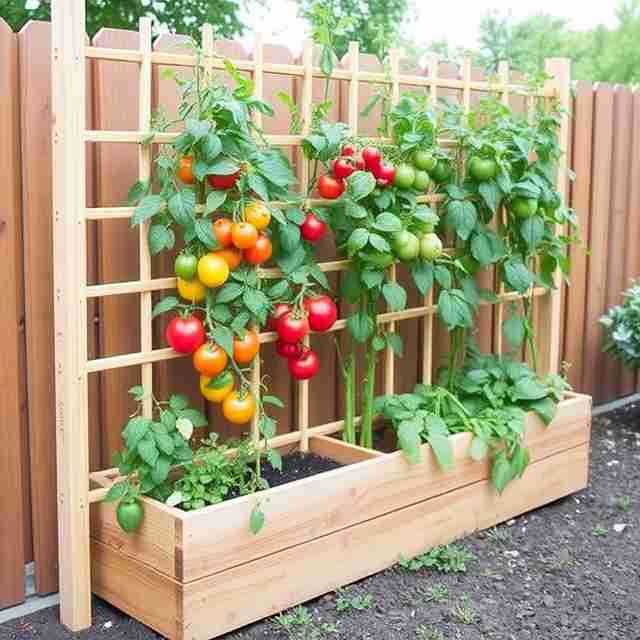
Why choose between a trellis and a planter when you can combine them into one? A trellis with integrated planter boxes is perfect for gardeners looking to save space while still growing delicious tomatoes.
Why it Works:
- Space-Efficient: This design combines the support of a trellis with the growing space of planters, making it perfect for smaller gardens or patios.
- Dual Purpose: You can use the planters to grow not just tomatoes, but other herbs or flowers, giving you a productive and attractive garden setup.
- Elevated Gardening: Raised planter boxes can reduce strain on your back and make it easier to manage your plants.
How to Build It:
- Choose a sturdy trellis with attached planter boxes at the bottom.
- Position the trellis in a sunny spot in your garden, ensuring the tomatoes will get enough light.
- Plant your tomatoes in the planters, and as they grow, train the vines up the trellis.
- Make sure the planters are well-drained to avoid waterlogging, which can affect tomato growth.
This trellis idea is perfect for those who want to maximize their gardening space and create an easy-to-maintain garden.
13. Expandable Bamboo Trellis
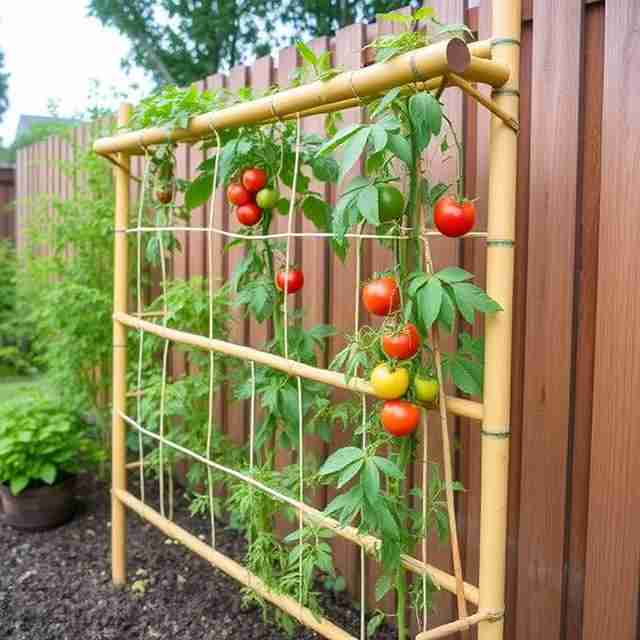
Bamboo is an eco-friendly and versatile material that can be used to create a lightweight, expandable tomato trellis. A bamboo trellis works great for those who want a sustainable option that is easy to adjust as their plants grow.
Why it Works:
- Eco-Friendly: Bamboo is a renewable resource, making it an environmentally friendly choice.
- Expandable Design: Bamboo trellises can be adjusted in height and width to suit your growing tomatoes, giving you more flexibility.
- Natural Aesthetic: The bamboo gives a natural, serene look to your garden, fitting well in gardens with a more rustic or tropical theme.
How to Build It:
- Use bamboo poles of varying lengths to form a vertical support structure.
- Secure the bamboo poles with natural twine or plant ties.
- Add horizontal bamboo pieces to form a grid or lattice for the tomatoes to climb.
- Expand the trellis as needed by adding more bamboo sections as the plants grow.
An expandable bamboo trellis is a beautiful, eco-conscious option that works well in a variety of garden settings.
14. Hanging Basket Trellis System
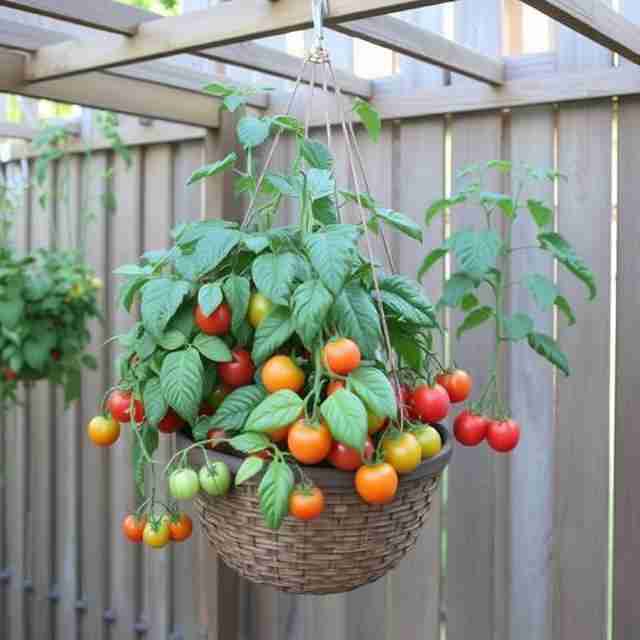
A hanging basket trellis system is perfect for small spaces or urban gardens where you might not have room for traditional ground-level trellises. By suspending baskets from overhead structures, you create an upward-growing space for your tomatoes to thrive.
Why it Works:
- Maximizes Vertical Space: Hanging baskets allow tomatoes to grow upwards, saving valuable floor space in your garden.
- Easy Harvesting: The height of the baskets makes it easy to pick tomatoes without bending down.
- Great for Small Spaces: Perfect for patios, balconies, or small garden plots where ground space is limited.
How to Build It:
- Install hooks or a rail system in your garden or on a patio to suspend the baskets.
- Choose hanging planters that are deep enough to hold the tomato plants as they grow.
- Plant your tomatoes in the hanging baskets, ensuring good drainage.
- As the plants grow, use twine or clips to train the vines to grow upwards.
Hanging baskets are a creative solution for urban gardening, allowing you to grow tomatoes even in the smallest spaces.
15. Woven Twig Trellis
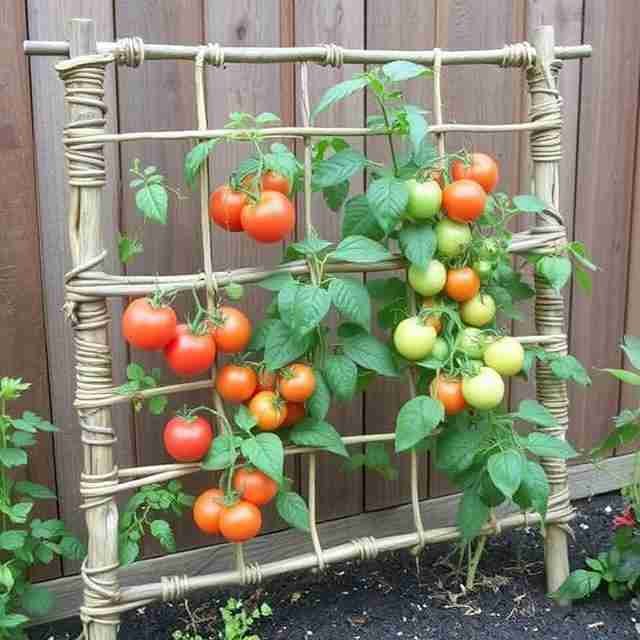
For a rustic, natural look, consider a woven twig trellis. Made from thin branches or twigs, this trellis creates a charming, whimsical backdrop for your tomato plants while offering them the support they need to grow strong.
Why it Works:
- Natural Look: A woven twig trellis blends beautifully into natural gardens, offering a rustic charm that’s hard to beat.
- Eco-Friendly: Using twigs or branches that you gather yourself makes this a sustainable and eco-friendly option.
- Flexible Design: You can adjust the size and shape of the trellis to suit your garden’s unique layout.
How to Build It:
- Collect thin twigs or branches from your garden or nearby areas.
- Weave them together to form a grid-like structure.
- Secure the ends of the twigs to a sturdy frame or directly to the ground.
- As the tomato plants grow, weave the vines into the trellis to provide support.
A woven twig trellis adds a whimsical and natural element to your garden while offering an eco-conscious alternative to traditional materials.
16. Trellis with Vertical Planters
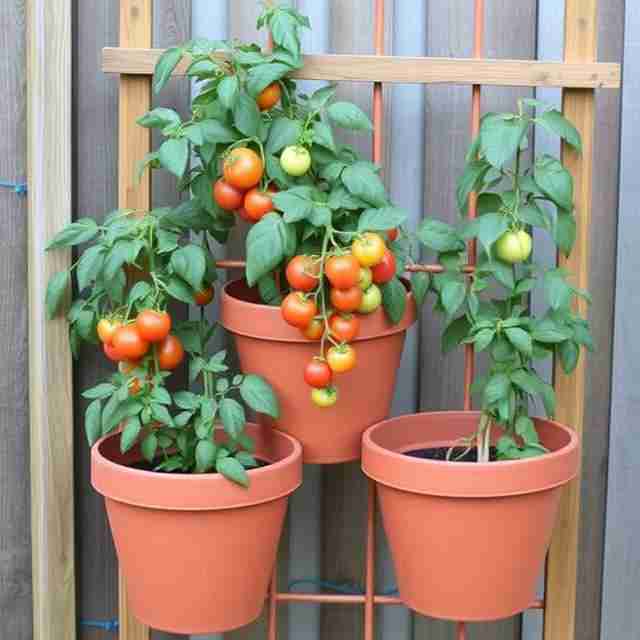
For gardeners looking to make the most of their space, combining a trellis with vertical planters is a genius idea. Vertical planters allow you to stack your plants, saving horizontal space while still providing ample room for tomatoes to grow upward.
Why it Works:
- Maximizes Space: Vertical planters use height to increase growing space, ideal for urban gardens or small yards.
- Increases Plant Diversity: The trellis supports tomatoes, while the planters can house additional plants like herbs or flowers.
- Easy Access: Elevated planters make it easy to tend to your plants without bending over.
How to Build It:
- Create a vertical frame or purchase a pre-made system with built-in planters.
- Plant tomatoes in the vertical planters, ensuring that each plant has enough space to grow.
- Train the vines upward along the trellis as they grow, ensuring they stay supported and off the ground.
This option is perfect for maximizing small garden spaces while keeping everything organized and easy to manage.
17. Cinder Block & Rebar Trellis
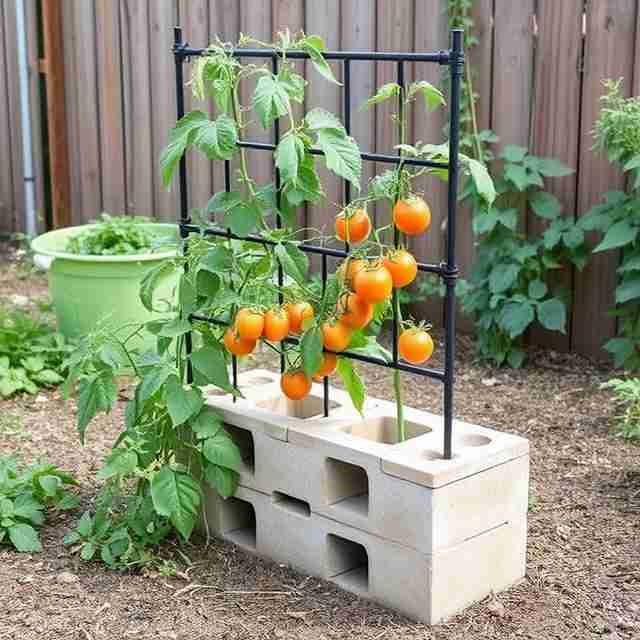
The industrial-chic cinder block and rebar trellis is a unique and highly durable option for supporting tomatoes. Using cinder blocks as the base and rebar as vertical supports, this trellis offers a modern and sturdy solution for any garden.
Why it Works:
- Extremely Durable: The cinder block and rebar combination is incredibly sturdy and will withstand harsh weather conditions.
- Modern Look: The industrial design is perfect for contemporary gardens that embrace a modern aesthetic.
- Minimal Maintenance: Once set up, this trellis requires very little maintenance and will last for many years.
How to Build It:
- Stack cinder blocks in a rectangular or square configuration to form a base.
- Insert rebar rods vertically into the holes of the cinder blocks, spacing them about 12-18 inches apart.
- Secure the rebar in place and add horizontal wire or twine for the tomatoes to climb.
The cinder block and rebar trellis offers a modern, sturdy solution for serious gardeners looking for something long-lasting.
Conclusion
With these 17 tomato trellis ideas, you now have a variety of solutions to suit any garden size, style, or level of expertise. Whether you’re looking for a budget-friendly, DIY project or a sleek, modern design, there’s a trellis style to match your needs. By choosing the right trellis, you can not only improve the health of your tomato plants but also enhance the aesthetic of your garden.
From classic wooden frames to eco-friendly bamboo options, the possibilities are endless. Remember to consider the size of your garden, the type of tomatoes you’re growing, and your personal style when making your decision. Happy gardening, and may your tomato harvest be abundant and delicious!


